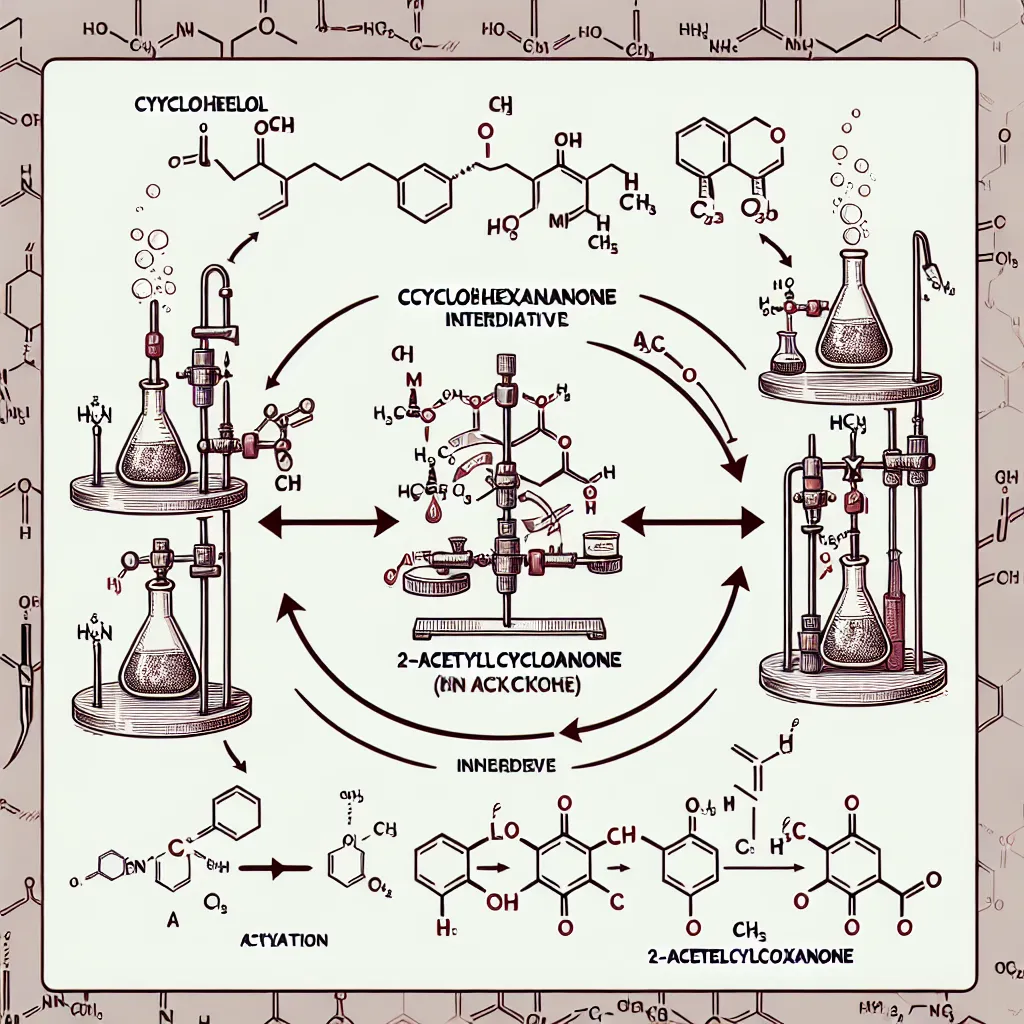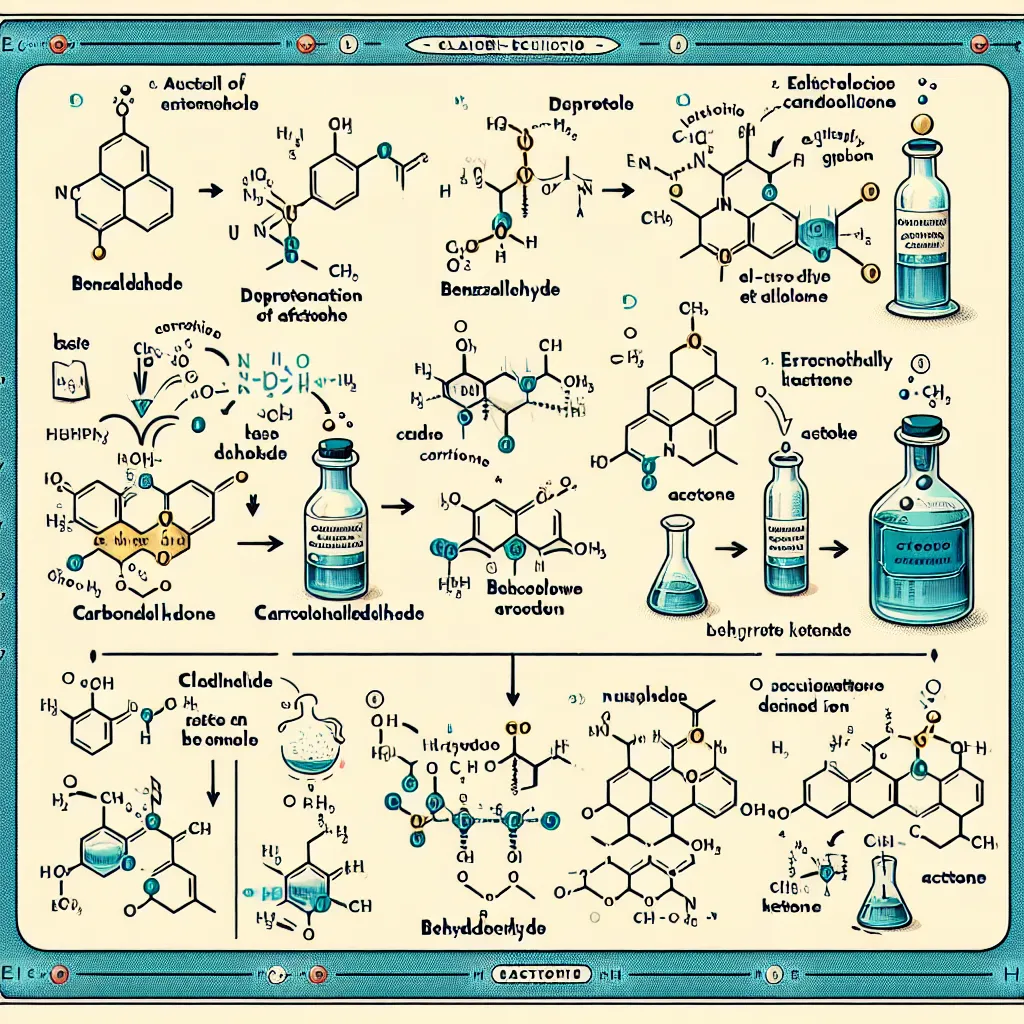Ask AI on The Internet
Question: 1000 WORDS INTRODUCTION TO CONDENSATION OF BENZALDEHYDE WITH ACETONE: THE CLAISEN-SCHMIDT REACTION. INTEXT REFERENCE
The Claisen-Schmidt reaction is a classic organic synthesis reaction named after two prominent chemists, Rainer Ludwig Claisen and J.G. Schmidt, who explored its potential in the 19th and early 20th centuries. This reaction is a type of aldol condensation that particularly involves the condensation of an aromatic aldehyde, such as benzaldehyde, with a ketone, typically acetone, under basic or acidic conditions to give α,β-unsaturated carbonyl compounds. The resultant compounds are of significant value in various industries, including pharmaceuticals, agrochemicals, and materials science. In the simplest terms, the Claisen-Schmidt reaction between benzaldehyde (C_6H_5CHO) and acetone ((CH_3)_2CO) proceeds via nucleophilic addition of the enolate ion of acetone to the carbonyl group of benzaldehyde. The mechanism involves three primary steps: generation of the enolate ion, nucleophilic addition to the carbonyl group of the aldehyde, and subsequent dehydration to form the final product, typically a conjugated enone. In the initial step, under basic conditions, acetone is deprotonated at the α-position by a strong base, such as sodium hydroxide (NaOH), to form an enolate ion. This enolate ion is critical to the reaction because it acts as a powerful nucleophile, ready to attack the electrophilic carbonyl carbon of benzaldehyde. \[ \text{CH}_3\text{COCH}_3 + \text{OH}^- \rightarrow \text{CH}_3\text{C(OH)CH}_2^- \rightarrow \text{CH}_2\text{C(O)CH}_3 + \text{H}_2\text{O} \] Next, the nucleophilic enolate ion attacks the electrophilic carbonyl carbon of benzaldehyde, leading to the formation of a β-hydroxyketone intermediate (commonly referred to as an aldol product). This step is crucial as it determines the regiochemistry of the final product. \[ \text{CH}_2\text{C(O)CH}_3 + \text{C}_6\text{H}_5\text{CH}=O \rightarrow \text{CH}_2\text{C(OH)(-)}\text{CH}_3-\text{C}_6\text{H}_5 \] The intermediate subsequently undergoes a dehydration reaction. This step can occur either spontaneously under basic conditions or can be facilitated by heating the reaction mixture. The dehydration step involves the removal of a water molecule, generating a double bond between the α and β positions relative to the original carbonyl group, ultimately forming the α,β-unsaturated enone. \[ \text{CH}_2\text{C(OH)(-)}\text{CH}_3-\text{C}_6\text{H}_5 \rightarrow \text{CH}_2\text{CH}=C(\text{OH})\text{-C}_6\text{H}_5 \rightarrow \text{C}_6\text{H}_5\text{CH}=CH\text{C(O)}\text{CH}_3 + \text{H}_2\text{O} \] This mechanism emphasizes the formation of cinnamaldehyde-type compounds, where the conjugated system confers added stability and unique reactivity patterns to the molecule. The Claisen-Schmidt reaction can be fine-tuned by varying the reaction conditions. For instance, the choice of base, solvent, and temperature can significantly influence the yield and purity of the desired product. The Claisen-Schmidt condensation is particularly useful for synthesizing chalcones, which have the general structure of 1,3-diphenyl-2-propen-1-one. Chalcones and their derivatives have garnered extensive attention due to their wide range of biological activities, including anti-inflammatory, antimicrobial, antiviral, and anticancer properties (Singh et al., 2014). The versatility of this reaction in synthesizing such bioactive molecules underscores its importance in medicinal chemistry. Furthermore, this reaction finds application in the synthesis of fine chemicals and polymers. For example, intermediates produced via the Claisen-Schmidt pathway are utilized in the fabrication of light-emitting diodes (LEDs) and organic photovoltaic cells, as the conjugated systems they form are effective in electron transport and light absorption (Wegner, 1992). The Claisen-Schmidt reaction is also noteworthy for its operational simplicity and the capacity to be catalyzed by both homogeneous and heterogeneous catalysts. For instance, basic alumina and other solid base catalysts can be employed to facilitate the reaction in a greener context, reducing the need for hazardous solvents and bases. Environmental considerations have further driven the development of sustainable methodologies based on the Claisen-Schmidt condensation. The use of water as a solvent and the employment of microwave-assisted synthesis are two innovative approaches that provide cleaner and more energy-efficient pathways for carrying out this reaction (Lenardão et al., 2007). These advancements align with the growing emphasis on green chemistry principles, aiming to minimize the environmental footprint of chemical processes. In conclusion, the Claisen-Schmidt reaction, particularly the condensation of benzaldehyde with acetone, stands as a cornerstone in organic synthesis. The reaction’s capacity to form conjugated enones with high efficiency and its adaptability to various conditions make it invaluable for synthesizing a diverse array of chemically and biologically significant molecules. As the field of synthetic organic chemistry continues to evolve, the Claisen-Schmidt reaction remains a fundamental and versatile tool, continually adapted to meet the advancing demands of science and industry. The ongoing research efforts to enhance the reaction’s efficiency and sustainability further underscore its enduring significance in both academic and industrial settings. References: - Singh, R. V., Sindhu, R. K., Deep, A., & Smith, A. (2014). Pharmacological Potential of Chalcones: A Mini-Review. Chemistry & Biology Interface. - Wegner, G. (1992). Chemical Materials with Designed Properties. Angewandte Chemie International Edition, 31(12), 1649-1663. - Lenardão, E. J., Liebelt, R. A., Silva, L. F., & Perin, G. (2007). Efficient and Green Claisen–Schmidt Condensation in Aqueous Medium. Tetrahedron Letters, 48(49), 7469-7473.
Think your answer is better than the AI's? Post it below.
Other Most Relevant Posts:
 Ask AI: 1000 WORDS INTRODUCTION TO Preparation of 2-Acetylcyclohexanone from Cyclohexanol .INTEXT REFERENCE
Ask AI: 1000 WORDS INTRODUCTION TO Preparation of 2-Acetylcyclohexanone from Cyclohexanol .INTEXT REFERENCE
 Ask AI: Would it be possible to use eluent solvent mixtures in the unsaturated mode (e.g. benzene chloroform)? Explain any difficulties that might arise.
Ask AI: Would it be possible to use eluent solvent mixtures in the unsaturated mode (e.g. benzene chloroform)? Explain any difficulties that might arise.
 Ask AI: 1000 words introduction toKINETICS OF AQUATION OF PENTAAMMINECHLOROCOBALT(III) CHLORIDE
[Co(NH3)5Cl]
2+. intext reference
Ask AI: 1000 words introduction toKINETICS OF AQUATION OF PENTAAMMINECHLOROCOBALT(III) CHLORIDE
[Co(NH3)5Cl]
2+. intext reference
 Unveiling the Synthesis of Cobalt Ammine Complexes: Delving into the Preparation of [Co(NH3)4CO3]NO3 and [Co(NH3)5Cl]Cl2
Unveiling the Synthesis of Cobalt Ammine Complexes: Delving into the Preparation of [Co(NH3)4CO3]NO3 and [Co(NH3)5Cl]Cl2
Question Tags
If you want your question answered by an AI, click here.



Post your own comment: